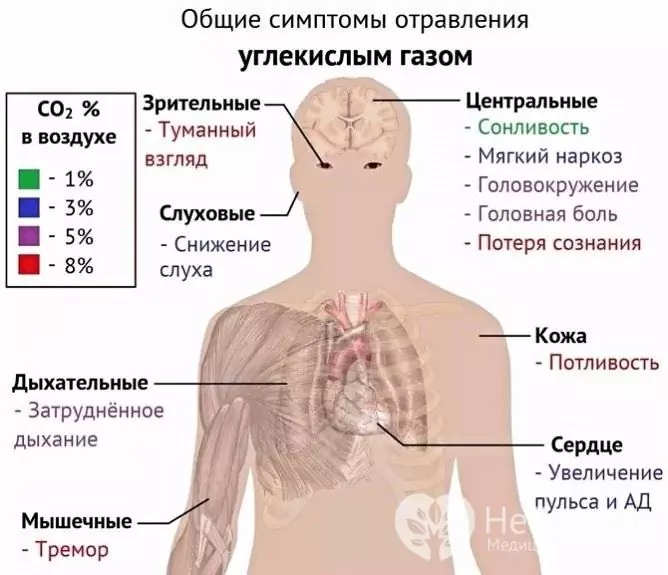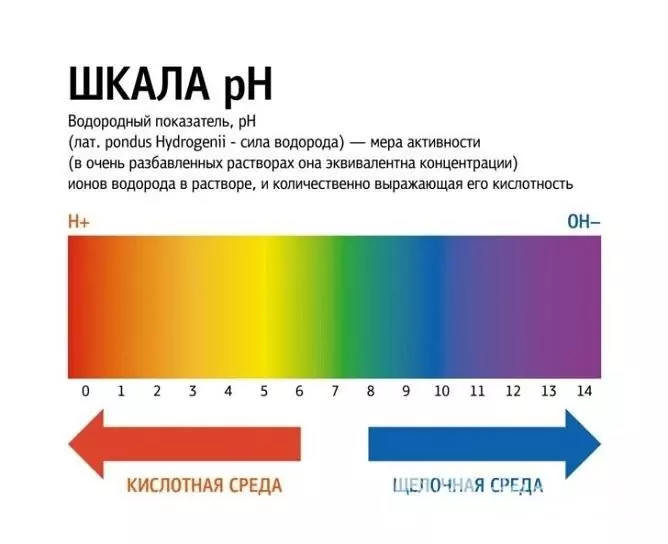- Author Rachel Wainwright [email protected].
- Public 2023-12-15 07:39.
- Last modified 2025-11-02 20:14.
Hypercapnia
The content of the article:
- Causes
- Kinds
- Signs
- Features of the course of hypercapnia in children
- Features of the course of hypercapnia in pregnant women
- Diagnostics
- Treatment
- Prevention
- Consequences and complications
Hypercapnia is an increased level of carbon dioxide in the blood; poisoning caused by carbon dioxide.
With hypercapnia in the blood, the partial pressure of carbon dioxide rises, which leads to a shift in the acid-base state (ACS) of the blood to the acidic side, that is, to the development of respiratory acidosis. As a result, the body triggers adaptive reactions aimed at correcting acid base balance.

Carbon dioxide poisoning - hypercapnia
Against the background of hypercapnia and respiratory acidosis, breathing becomes deeper and more frequent, which causes an increase in the minute breathing volume and contributes to a decrease in the partial pressure of carbon dioxide in the blood, and the return of acid base balance to normal.
Causes
The causes of hypercapnia are manifold; they are divided into several large groups:
- Violations of the mechanics of respiratory movements in some pathological conditions [with botulism, multiple sclerosis, poliomyelitis, muscular dystrophy, myasthenia gravis, the use of muscle relaxants, Pickwick's syndrome, morbid obesity, fractures of the sternum and (or) ribs, scoliosis, severe pneumosclerosis].
- Depression of the respiratory center in the brain stem (with the use of narcotic analgesics and general anesthetics, circulatory arrest, damage to the central nervous system, prolonged inhalation of oxygen).
- Disorders of gas exchange in the lung tissue (with Hammen-Rich disease, pneumothorax, Mendelssohn's syndrome, respiratory distress syndrome, pulmonary edema, chronic obstructive pulmonary diseases, acute pneumonia).
Hypercapnia can develop when forced to stay in a closed room without ventilation.
Kinds
By the nature of the course of hypercapnia, it happens:
- sharp;
- chronic.
Depending on the reason:
- endogenous - caused by internal causes (primary disease);
- exogenous - caused by external factors (for example, being in a stuffy room).
Signs
Clinically, hypercapnia can manifest itself with a slow onset of symptoms over a long time, and sometimes it forms with lightning speed.
Signs of hypercapnia:
- rapid breathing (tachypnea);
- feeling short of breath;
- excitement, followed by further depression of consciousness;
- marbling of the skin, which then turns into pronounced cyanosis;
- participation in the act of breathing of the auxiliary muscles;
- increased blood pressure and tachycardia, which, as the condition worsens, are replaced by hypotension and bradycardia;
- excessive sweating (hyperhidrosis);
- heart rhythm disturbances;
- headache, dizziness;
- decreased performance;
- convulsive seizures.

Hypercapnia symptoms
Features of the course of hypercapnia in children
In children, hypercapnia develops much faster and is more severe than in adults. This is due to the anatomical and physiological characteristics of the child's body, such as:
- the narrowness of the respiratory passages - accumulations of mucus and swelling of the mucous membrane against the background of even minor inflammation can lead to a violation of their free passage;
- underdevelopment and weakness of the respiratory muscles;
- the departure of the ribs from the sternum is almost at a right angle, which limits the excursion (mobility) of the chest in the act of breathing.
Features of the course of hypercapnia in pregnant women
In pregnant women, especially in the third trimester, any breathing disorders can cause rapidly developing hypercapnia, which is associated with the following features:
- oxygen consumption during pregnancy increases by 20-23%;
- the type of breathing changes to the chest, the abdominal muscles cease to play the role of auxiliary respiratory muscles;
- there is a high standing of the diaphragm caused by the growing uterus, which prevents the deepening of inspiration when necessary.

Hypercapnia can develop rapidly in late pregnancy
Diagnostics
The primary diagnosis of hypercapnia is based on an analysis of the clinical picture. To confirm the diagnosis, as well as to clarify the severity of respiratory failure, a study of the acid-base state of the blood is carried out. Diagnostic signs of hypercapnia:
- an increase in the partial pressure of carbon dioxide - over 45 mm Hg. Art. (the norm is 35-45 mm Hg);
- decrease in blood pH - less than 7.35 (normal - 7.35-7.45);
- an increase in the content of bicarbonate in the blood, which is of a compensatory nature.
An analysis of the carbon dioxide content in the exhaled air is also carried out using a capnograph.

To diagnose hypercapnia, a study of the acid-base state is carried out
Treatment
Therapy for hypercapnia is aimed at eliminating the cause that caused it.
If symptoms of hypercapnia appear after being in a stuffy room, it is enough to go outside or ventilate the room: this quickly leads to an improvement in the patient's condition.
Treatment of hypercapnia against the background of inflammatory diseases of the respiratory system requires the appointment of antibacterial agents, bronchodilators, anti-inflammatory drugs.
With hypercapnia caused by an overdose of narcotic analgesics, the introduction of a specific antidote, Nalorphine, is indicated.

Sometimes, to get rid of the symptoms of hypercapnia, it is enough to ventilate the room
In acute hypercapnia, the patient is allowed to breathe humidified oxygen through nasal catheters or a face mask. In the case of a severe general condition of the patient, the issue of intubation and transfer to artificial ventilation is decided.
Prevention
In order to prevent hypercapnia, it is necessary:
- regularly ventilate the premises;
- spending time outdoors;
- timely treat diseases that can lead to the development of respiratory disorders;
- quit smoking and drug use.
Consequences and complications
Hypercapnia is most dangerous for newborns and children in the first months of life. It can cause the development of severe neurological disorders, including:
- epilepsy;
- cerebral palsy;
- delayed psychomotor development.
Long-term hypoxia in adults can lead to a hypertensive crisis, hemorrhagic stroke, myocardial infarction.

Elena Minkina Doctor anesthesiologist-resuscitator About the author
Education: graduated from the Tashkent State Medical Institute, specializing in general medicine in 1991. Repeatedly passed refresher courses.
Work experience: anesthesiologist-resuscitator of the city maternity complex, resuscitator of the hemodialysis department.
The information is generalized and provided for informational purposes only. At the first sign of illness, see your doctor. Self-medication is hazardous to health!






